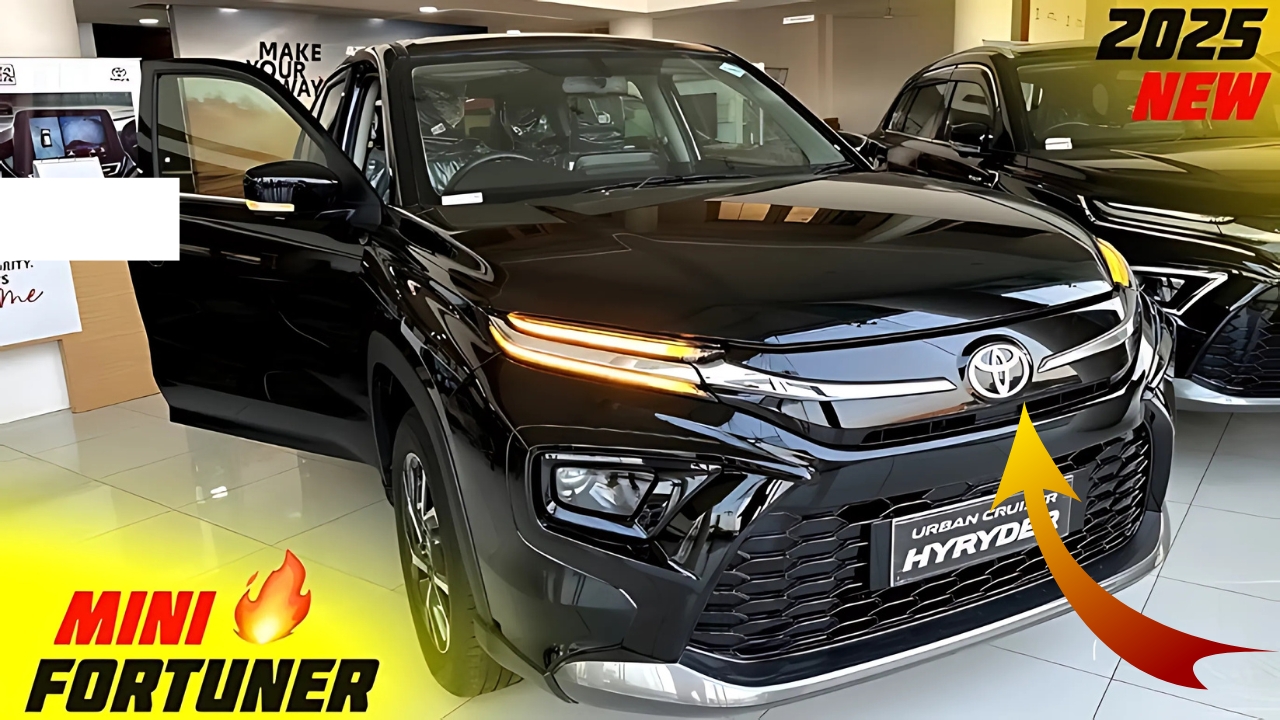Toyota Hyryder : When Toyota launched the Urban Cruiser Hyryder in mid-2022, car enthusiasts quickly recognized a fascinating aspect—the compact SUV showcased distinct design cues borrowed from its more premium counterpart, the Fortuner.
This intentional design strategy has established a captivating value proposition in India’s competitive SUV landscape: Fortuner-esque styling at approximately one-third the cost.
The most notable connection to Toyota’s flagship SUV is evident in the Hyryder’s front-end design.
A prominent chrome-accented grille featuring similar horizontal slats embodies the recognizable Toyota aesthetic that has come to symbolize the brand’s luxury offerings.
The sharp, angular headlamp assemblies, complete with their distinctive LED daytime running lights, reflect the bold styling that has cemented the Fortuner’s commanding presence on the road.
“I initially confused a Hyryder for a compact Fortuner variant when I first spotted it at dusk,” shares Vikram Desai, a proud owner of a 2019 Fortuner.
“It wasn’t until it approached that I realized it was a different model altogether. Toyota has impressively managed to translate their upscale design elements into a smaller platform.”
This visual connection extends along the Hyryder’s profile, where pronounced wheel arches and an upward-sloping beltline reminisce the larger SUV’s silhouette in a condensed form.
The classic roof rails, serving a functional purpose, further accentuate the family resemblance.
Moreover, the alloy wheel designs on higher-end variants of the Hyryder closely resemble those found in specific Fortuner editions, showcasing multi-spoke configurations with machined surfaces that exude a level of sophistication rarely seen in the sub-₹20 lakh segment.
Toyota Hyryder Premium Interior Touches Within Reach
The design parallels are not limited to the exterior. Inside the cabin, Toyota has integrated several Fortuner-like elements, albeit with materials that reflect the price variance.
The layered dashboard design, with its horizontally oriented components, undeniably shares lineage with the more expensive Toyota SUVs.
While the steering wheel is slightly smaller, it maintains similar control arrangements and contours.
Sanjay Krishnan, who recently opted for a Hyryder after evaluating several other models, commented: “Having spent time in my colleague’s Fortuner, I instantly recognized certain interior features—the door handle, the way the center console is shaped, even the subtle details like the window switch panels.
They’ve clearly been designed with different cost targets in mind, yet the overall design concept feels interconnected.”
The higher trim levels of the Hyryder come equipped with ventilated front seats, a panoramic sunroof, and a 360-degree camera system—features that were previously exclusive to much more expensive vehicles.
This inclusion of premium features strengthens its value proposition for buyers looking for Fortuner-like luxuries without the hefty price tag.
Toyota Hyryder Sensible Engineering Beneath Familiar Styling
Beneath its Fortuner-inspired outer shell, the Hyryder incorporates engineering decisions that align well with its pricing and intended usage.
Rather than attempting to replicate the Fortuner’s ladder-frame construction and off-road capabilities, Toyota sensibly opted for a monocoque structure shared with Maruti Suzuki, developed under their partnership.
This platform-sharing strategy facilitates attractive pricing (starting around ₹10.5 lakh, ex-showroom) while still ensuring comfortable performance suited for urban driving.
The offered mild hybrid and strong hybrid powertrains—technologies not available in the Fortuner—give the Hyryder certain technological advantages over its pricier sibling.
Dr. Anand Kulkarni, an automotive technology consultant, remarks: “Toyota has been very strategic with this move. They’ve borrowed aspirational design elements from the Fortuner and integrated more modern, efficiency-driven powertrains.
The hybrid system represents advanced technology compared to what’s currently on offer in the Fortuner, making the cost difference even more compelling.”
Toyota Hyryder Market Positioning That Leverages Legacy
Toyota’s strategy with the Hyryder illustrates astute brand management—capitalizing on the established visual equity of their flagship SUV to boost the appeal of their entry into the fiercely competitive compact SUV segment.
This tactic resonates particularly well with value-oriented Indian consumers who appreciate identifiable luxury design elements.
“Initially, we were looking into the Hyundai Creta and Kia Seltos,” mentions Priya Mehta, who bought a hybrid variant of the Hyryder in December 2022.
“The resemblance to the Fortuner played a significant role in our choice—it possesses a certain road presence that most compact SUVs lack.
Several relatives mistook it for a much pricier vehicle, which is, I must admit, pretty gratifying.”
For those who admire the Fortuner’s imposing aesthetics but find its ₹35-50 lakh price range daunting, the Hyryder presents an enticing alternative.
It offers around 70% of the visual appeal at just 30% of the cost—an attractive proposition explaining the Hyryder’s rising popularity on Indian roads, even with strong competition from established brands like Hyundai, Kia, and Maruti Suzuki.
As Indian buyers increasingly seek vehicles that maximize perceived value while minimizing cost, the Hyryder’s design, inspired by the Fortuner, could be Toyota’s smartest marketing strategy in years.
